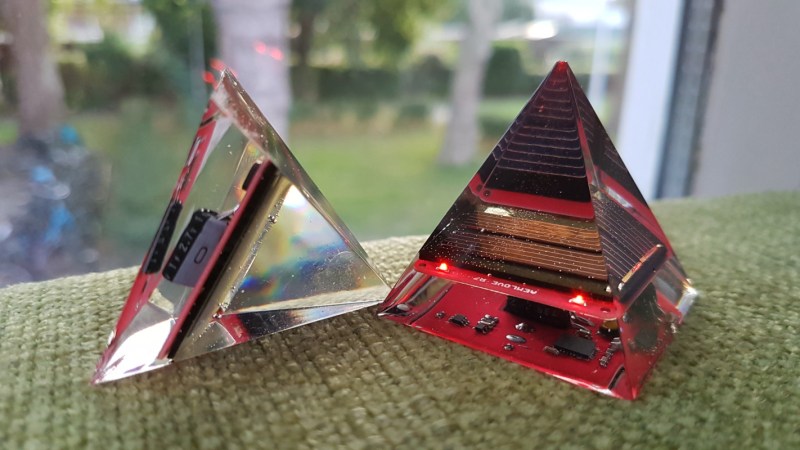A few years ago a fad ripped through the makersphere where people would build cheap, solar powered LED blinkers, glue a magnet to them, and throw them on anything metal. It was an interesting time, but luckily did not last for too long. With some effort and craftsmanship, though, the solar throwie idea can be turned into something more elegant, though, such as this solar harvesting blinking gadget.
Like its predecessors, the device itself behaves simply, although this one is equipped with a small supercapacitor which can run the device for 8 hours without sun. It has a small solar panel which can charge the capacitor in five minutes, and from there the LEDs inside simply blink. The quality shows in the final packaging, as [Jasper] has taken to encasing them in epoxy shapes such as pyramids, for a nice paperweight or tchotchke. It is also noteworthy because of Jasper’s test device; since he is mass producing them he needed something to test each board for functionality before encasing them in the epoxy, and he built a small pen tester specifically for them too.
While the build is pretty straightforward, anyone looking to enclose a simple circuit in epoxy without bubbles or other problems might want to check this one out. It would also be a good platform for building other throwie-like projects on top of. In the past they didn’t just blink lights but also did things like run small Linux servers.















These are amazing! Unlike original throwies which sucked.
Could be a stylish BLE U2F security key.
“anyone looking to enclose a simple circuit in epoxy without bubbles”
Someone told me recently that a heat gun can be used to ‘draw’ the bubbles out… can anyone confirm this?
Not draw them out, only pop the bubbles near the surface.
A vacuum chamber works best. It makes the bubbles very large, so they can raise to the surface, and when pressure returns to normal, it makes any remaining bubbles much smaller. This is generally done on the bucket of freshly mixed epoxy, before casting, but can be repeated after casting if the cast fits in the vacuum chamber.
I’ve done some stuff like this. A vacuum chamber is best but other options for pushing bubbles out are high G-forces (slamming it down onto a table; centrifuge) or vibration (orbital sander against edge of the table). Another strategy is to heat up the resin before pouring to reduce its viscosity. Let’s just say it’s tricky.
Yip I’ve just finished atable.You can use a heat gun or a gas blower is better and You light stroke over your product .
Tip… take your time
Think mine used an ICL7660S and a panel from a solar calculator.
Incidentally the cause of failure was actually the Epoxy going yellow not component issues: could probably sand off the surface layer and fix it.
Can you elaborate why you used ICL7660S? And how you made a LED blink?
Nice epoxy job but the circuit seems like overkill. A simple CMOS 4001 gated flasher like this one https://hackaday.io/project/28344-10-year-led-flasher (remove the joule thief part) would work just as well, just use a 5V solar cell and a 5V supercap.
I’m thinking that if you could overcome the yellowing of the epoxy, air dropping thousands of these things with wi-fi instead of blinkers could be the start of a mesh network in emergency zones…
I’d hate to get hit by one of the pointy ends of the pyramid after they’ve been air dropped!
B^)
Night light equipped caltrops?
I think it would be neat to make one with a BEAM LED pummer in it or a PIC 12F programmed to flash like fireflies.
How long will this thing last? I mean will it be dead in a year or will people be worshiping it in the year 10,000?
I think the solar panel degrades in 30 years and rest will live forever